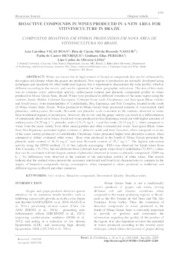Bioactive compounds in wines produced in a new area for vitiviniculture in Brazil.
Bioactive compounds in wines produced in a new area for vitiviniculture in Brazil.
Author(s): VILAS BOAS, A. C.; NASSUR, R. de C. M. R.; HENRIQUE, P. de C.; PEREIRA, G. E.; LIMA, L. C. de O.
Summary: Wines are known for its high content of bioactive compounds that can be influenced by the region and climate where the grapes are produced. New regions of production are normally developed using techniques and standards for other traditional regions, but is important to characterize the wine profile, which is different according to the terroir, and can be important for future geographic indications. The aim of this study was to evaluate color, antioxidant activity, anthocyanin content and phenolic compounds profile in wines produced in Minas Gerais State, Brazil. Wines were produced in different wineries of the same region using the varieties Syrah, Merlot, Cabernet Sauvignon, Cabernet Franc (red), Chardonnay and Sauvignon Blanc (white) and Syrah (rose), from municipalities of Cordislândia, Boa Esperança and Três Corações, located in the south of Minas Gerais State, Brazil. Wines produced in Minas Gerais State presented contents of t-resveratrol, total phenolics, anthocyanins, flavonols, flavanols and phenolic acids consistent to the contents observed in wines from traditional regions of production. However, the terroir and the grape variety can result in a differentiation of compounds observed in wines. Syrah red wines produced in Boa Esperança stood out with higher amounts of anthocyanins (24.29 mg L-1), phenolic acids (123,19 mg L-1 ) and flavonols (35.55 mg L-1), when compared to wines from the same variety from other municipalities and other evaluated red wines. Sauvignon Blanc wines from Boa Esperança presented higher contents of phenolic acids and total flavonols, when compared to wines of the same variety produced in Cordislândia. Chardonay wines presented higher total phenolics content, when compared to ohther evaluated white wines. Rose wine produced in the South of Minas Gerais presented the phenolic acids content of 36,33 mg L-1 and total flavonols content of 29,7 mg L-1. The highest antioxidant activity using the DPPH method, (% of free radicals scavenging - FRS) was observed for Syrah wines from Três Corações, (75.37%), but not different from Cabernet Sauvignon wines from Cordislândia (72.50%), values that can be correlated with the largest content of phenolics observed in wines as phenolic compounds (3009 mg L-1). No differences were observed in the contents of the antioxidant activity of white wines. This results indicate that the studied wines present the necessary nutritional and beneficial characteristics to compete in the supply of bioactive compounds during consumption, when compared to wines produced in traditional and different regions in Brazil and other countries.
Publication year: 2019
Types of publication: Journal article
Unit: Embrapa Grape & Wine
Keywords: Bioactive compounds, Brazilian wines, Quality, Quality control, Resveratrol, Uva, Vitis Vinifera
Observation
Some of Embrapa's publications are published as ePub files. To read them, use or download one of the following free software options to your computer or mobile device. Android: Google Play Books; IOS: iBooks; Windows and Linux: Calibre.
Access other publications
Access the Agricultural Research Database (BDPA) to consult Embrapa's full library collection and records.
Visit Embrapa Bookstore to purchase books and other publications sold by Embrapa.

